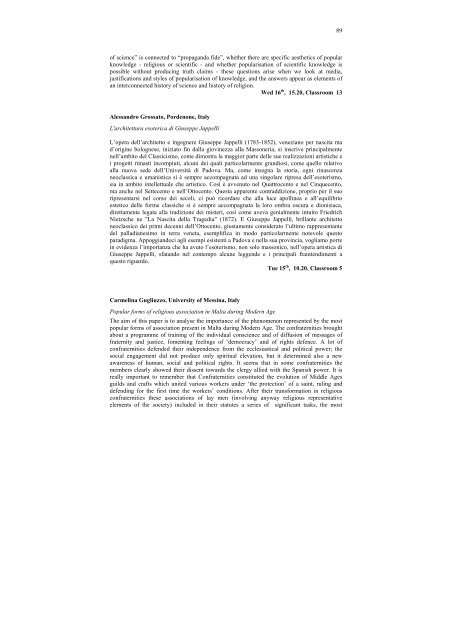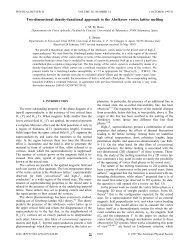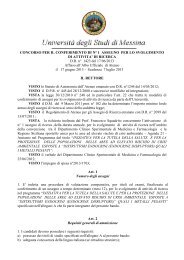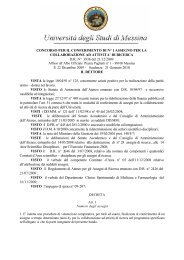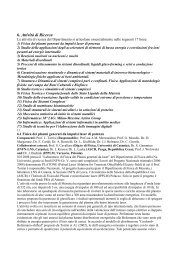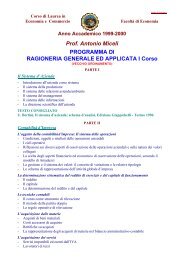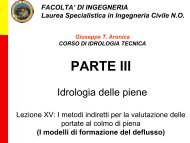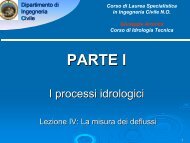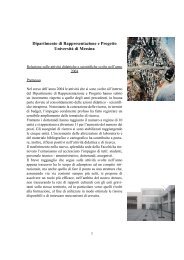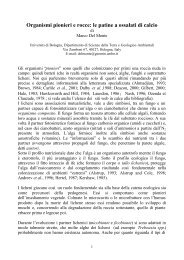PROGRAMME AND ABSTRACTS - Università degli Studi di Messina
PROGRAMME AND ABSTRACTS - Università degli Studi di Messina
PROGRAMME AND ABSTRACTS - Università degli Studi di Messina
You also want an ePaper? Increase the reach of your titles
YUMPU automatically turns print PDFs into web optimized ePapers that Google loves.
of science” is connected to “propaganda fide”, whether there are specific aesthetics of popular<br />
knowledge - religious or scientific - and whether popularisation of scientific knowledge is<br />
possible without producing truth claims - these questions arise when we look at me<strong>di</strong>a,<br />
justifications and styles of popularisation of knowledge, and the answers appear as elements of<br />
an interconnected history of science and history of religion.<br />
Wed 16 th , 15.20, Classroom 13<br />
Alessandro Grossato, Pordenone, Italy<br />
L'architettura esoterica <strong>di</strong> Giuseppe Jappelli<br />
L’opera dell’architetto e ingegnere Giuseppe Jappelli (1783-1852), veneziano per nascita ma<br />
d’origine bolognese, iniziato fin dalla giovinezza alla Massoneria, si inscrive principalmente<br />
nell’ambito del Classicismo, come <strong>di</strong>mostra la maggior parte delle sue realizzazioni artistiche e<br />
i progetti rimasti incompiuti, alcuni dei quali particolarmente gran<strong>di</strong>osi, come quello relativo<br />
alla nuova sede dell’<strong>Università</strong> <strong>di</strong> Padova. Ma, come insegna la storia, ogni rinascenza<br />
neoclassica e umanistica si è sempre accompagnata ad una singolare ripresa dell’esoterismo,<br />
sia in ambito intellettuale che artistico. Così è avvenuto nel Quattrocento e nel Cinquecento,<br />
ma anche nel Settecento e nell’Ottocento. Questa apparente contrad<strong>di</strong>zione, proprio per il suo<br />
ripresentarsi nel corso dei secoli, ci può ricordare che alla luce apollinea e all’equilibrio<br />
estetico delle forme classiche si è sempre accompagnata la loro ombra oscura e <strong>di</strong>onisiaca,<br />
<strong>di</strong>rettamente legata alla tra<strong>di</strong>zione dei misteri, così come aveva genialmente intuito Friedrich<br />
Nietzsche ne "La Nascita della Trage<strong>di</strong>a" (1872). E Giuseppe Jappelli, brillante architetto<br />
neoclassico dei primi decenni dell’Ottocento, giustamente considerato l’ultimo rappresentante<br />
del palla<strong>di</strong>anesimo in terra veneta, esemplifica in modo particolarmente notevole questo<br />
para<strong>di</strong>gma. Appoggiandoci agli esempi esistenti a Padova e nella sua provincia, vogliamo porre<br />
in evidenza l’importanza che ha avuto l’esoterismo, non solo massonico, nell’opera artistica <strong>di</strong><br />
Giuseppe Jappelli, sfatando nel contempo alcune leggende e i principali frainten<strong>di</strong>menti a<br />
questo riguardo.<br />
Tue 15 th , 10.20, Classroom 5<br />
Carmelina Gugliuzzo, University of <strong>Messina</strong>, Italy<br />
Popular forms of religious association in Malta during Modern Age<br />
The aim of this paper is to analyse the importance of the phenomenon represented by the most<br />
popular forms of association present in Malta during Modern Age. The confraternities brought<br />
about a programme of training of the in<strong>di</strong>vidual conscience and of <strong>di</strong>ffusion of messages of<br />
fraternity and justice, fomenting feelings of ‘democracy’ and of rights defence. A lot of<br />
confraternities defended their independence from the ecclesiastical and political power; the<br />
social engagement <strong>di</strong>d not produce only spiritual elevation, but it determined also a new<br />
awareness of human, social and political rights. It seems that in some confraternities the<br />
members clearly showed their <strong>di</strong>ssent towards the clergy allied with the Spanish power. It is<br />
really important to remember that Confraternities constituted the evolution of Middle Ages<br />
guilds and crafts which united various workers under ‘the protection’ of a saint, ruling and<br />
defen<strong>di</strong>ng for the first time the workers’ con<strong>di</strong>tions. After their transformation in religious<br />
confraternities these associations of lay men (involving anyway religious representative<br />
elements of the society) included in their statutes a series of significant tasks, the most<br />
89


